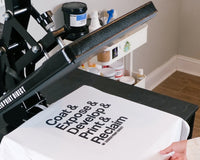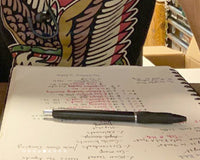To screen print a design onto a t-shirt you need to create a stencil for your artwork. A stencil can be made in several ways but in this blog, we are going to discuss how to make a silk screen stencil using two different methods. There is a DIY method using a vinyl cutter, often referred to as Cricut screen printing, and there is a traditional screen-printing method that uses screen printing emulsion and light.
These two methods vary greatly, however, they result in the same finished good, a printed design on your desired substrate. Below we will break down the materials you need for both Cricut screen printing and traditional screen printing and the directions to complete each method. We hope that by the end of this blog you will feel confident in one of the methods and be able to create your very first stencil.
Price is something to keep in mind when looking at these two methods. How much money do you want to spend on your initial screen printing setup? If you are starting to screen print as a side hustle then traditional screen printing might be a bit more expensive but will be a better long-term set-up. If you are looking to print as a hobby and not as frequently then it may be better to go with a DIY crafty set-up. A DIY screen printing set-up will give you more flexibility for other projects as some of the equipment needed for this method can be used for other art forms.
The DIY Craft Method
As previously mentioned, this Cricut screen printing method is used for those looking to print as a hobby or to just produce a few prints of each design. It is a great introduction to screen printing and will help you to understand the printing process if you don’t have any prior experience with it.
Supplies & Equipment needed:
- Mesh Screen: Mesh count depends on the type of ink you are printing with. Please refer to this blog for information on selecting the proper mesh count
- Vinyl/plotter cutter (ex. Silhouette cameo/ Cricut)
- Vinyl
- Weeding Tool
- Masking Tape
- Design tools such as Canva or Photoshop
- First you will need to create the artwork you want to print. You need to mirror your design, similar to the way you would iron-on something. If you don’t mirror the image, it will print reversed. Once you have created this artwork, print it on your vinyl cutter.

Mirrored Image. Photo Credit: https://www.thecountrychiccottage.net/
2. Once the artwork is printed you are going to weed your design, this means you need to take the vinyl away from the areas you want to be printed with ink.

Traditional Screen-Printing Method
Supplies & Equipment needed:
- Mesh Screen: Mesh count depends on the type of ink you are printing with. Please refer to this blog for information on selecting the proper mesh count
- Inkjet Film
- Emulsion: type depends on what type of ink you are using. Please reference this blog for information on choosing the right emulsion.
- Scoop Coater/ Flat Smooth Credit Card/ Popsicle Stick
- Light Safe Room: Can be a closet, cabinet, or cardboard box big enough to keep the screen in
- Exposure Unit/ DIY Light Unit: Please reference this blog for an easy DIY exposure unit
- Tape
- Design tool such as Canva or Adobe Photoshop
This method is most popular for those looking to start silk screen printing as a side hustle. There is a bit of a learning curve when it comes to working with emulsion and it will require practice and patience, but the results are much more durable than vinyl. You can achieve large volume print runs with this method of printing i.e. 1000s of t-shirts.
Important Note: Please keep in mind whenever working with emulsion you must be in a light-safe room. If emulsion is exposed to light before the exposure process is supposed to take place, it will prematurely expose and you will not get desired results.
Let’s jump into the instruction:
- Open the emulsion in a light-safe room and pour it into a scoop coater. If you are not using a scoop coater you will pour the emulsion directly onto the mesh screen.

If you don’t have a scoop coater, take a flat card and spread the emulsion as evenly as possible. over the screen, the coat shouldn’t be thick.

- Take your coated screen and let it dry overnight until it is dry to the touch. The screen needs to remain in a light safe room with little humidity.
- While your screen is drying, create your artwork and print the artwork onto inkjet film. The ink on the film needs to be nice and dark, you can perform a quick test to see if the ink is dark enough. To test: Hold the inkjet film up to the sun, no light should come through the black ink. If light shines through you need to reprint or use a different printer with darker ink settings.

If you are using an exposure unit with light shining down onto the screen you will take the inkjet film with your printed image and place it on the print side of the screen flipped and reversed. If the light is above the image, we recommend that the light is 14-18 inches above the screen.
If you are using an exposure unit with the light shining up onto the screen you will place the inkjet film onto the light source and then place the screen (print side down) on top of the ink jet film with the image reversed and flipped. See the image below.

- It is time to expose the screen. Exposure time will vary depending on the emulsion and the light source you are using. Please refer to the image below for approximate exposure times. We highly recommend using an exposure calculator to dial in exact exposure times.
7. Your screen is exposed, now it must be developed. Take the screen to a sink or washout booth and rinse out the image with water. This does not require the use of a pressure washer. This can be done with a normal garden hose.
You now have a screen ready to print!
If any of these instructions are unclear, please reach out to our team, we would love to assist you in creating your first silk screen stencil. Screen printing is an art form and like art, it takes time and practice to perfect! Our staff understands the difficulties of printing as we are printers ourselves. We know it can be frustrating, but we are here to make you a confident printer! Your success is our success.
Let's Talk
Remember, we are here to help! Drop a comment below or email our support team at info@screenprintdirect.com







